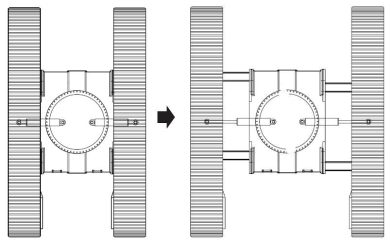
As with the Undercarriages with telescopic sliding arms, in this track variation system too, the displacemente of the crawlers is purely horizontal. A distinctive feature of the carriages with parallel sliding arms is that the right and left arms, of equal size, are welded to the crawlers. This allows for two separate, non coincident parallel axes. Likewise the seats of these extensions are also arranged on parallel axes.
Given the non-coincidence of the axles on which these forces are discharged, the use of a parallel sliding arms system generates greater asymmetry compared to an undercarriage with telescopic sliding arms.
The frame is also increased in lenght, because of the need to support the sliding seats. On the other hand, the undercarriages with parallel sliding arms present a considerable reduction of the clearances, thus making them more suitable for machines such as cranes, which are subject to the dynamic force of the wind.

As with the Undercarriages with telescopic sliding arms, in this track variation system too, the displacemente of the crawlers is purely horizontal. A distinctive feature of the carriages with parallel sliding arms is that the right and left arms, of equal size, are welded to the crawlers. This allows for two separate, non coincident parallel axes. Likewise the seats of these extensions are also arranged on parallel axes.
Given the non-coincidence of the axles on which these forces are discharged, the use of a parallel sliding arms system generates greater asymmetry compared to an undercarriage with telescopic sliding arms.
The frame is also increased in lenght, because of the need to support the sliding seats. On the other hand, the undercarriages with parallel sliding arms present a considerable reduction of the clearances, thus making them more suitable for machines such as cranes, which are subject to the dynamic force of the wind.